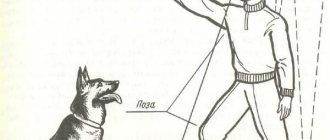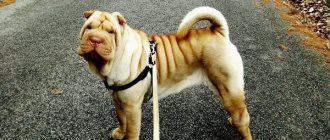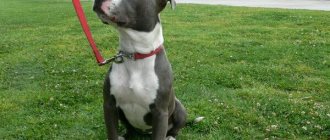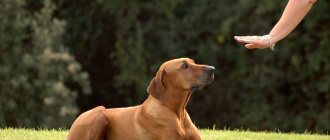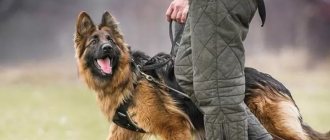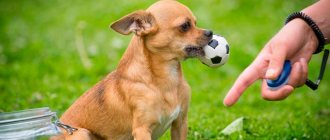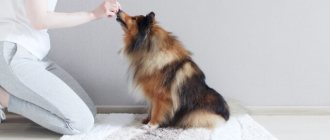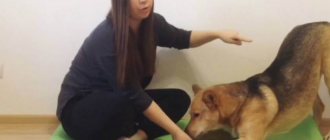Raising a dog is a long and consistent process that must begin from puppyhood. Training allows you to correct an animal's behavior, making it predictable and controllable. Training requires a lot of effort and time, but the result justifies all the costs. Such interaction improves the pet’s social life - you can take him for walks without fear of causing inconvenience to others, and intellectual stress has a beneficial effect on the overall development of the body. There are different methods and techniques of training; in this article we will look at simple ways to teach a dog commands.
Where to start teaching your dog commands
It is recommended to teach the puppy commands from a very early age, when the dog comes into active contact with the owner. Depending on the breed, this is 4-6 months, but adult individuals can also correct their behavior - it will take more time. Before starting classes, get all the necessary vaccinations and check the puppy’s health (hearing, vision and coordination). Dog handlers recommend getting the dog to contact you and respond to your name - this will make it easier to interact with the animal during training.
At home
It is recommended to teach commands through games and the feeding process. It is necessary to ensure that the puppy perceives his name well and responds to it when exposed to any stimuli. In addition, you need to teach your pet to comfortably accept the collar and leash. You can put on ammunition from a very young age so that the animal begins to get used to the process.
Establishing contact with your pet while feeding is a simple initial exercise. To do this, you need to pour food into a bowl and do not let the dog near it. Get her to look into your eyes; eye contact should be for at least 5 seconds. Then let your pet eat. After teaching the “sit” command, this process can be complicated by sitting the dog at some distance from the bowl.
On the street
Before starting active training, you should teach the dog to respond to a name against the background of smells and sounds on the street, and to calmly tolerate walking on a leash. After your puppy's routine vaccination, you can start going for walks. You should use a short leash, which makes it easier to achieve contact and control.
If your pet loves active games and there is an area with a fence, it is useful to use a ball outside. Your task is to throw the ball, and the dog must return to you. There is no need to worry if the puppy does not give up the toy at first; the main task at this stage is to teach the dog to respond to your voice and return. You should start training classic commands when you learn to quickly find contact with your pet - this increases the effectiveness of the training.
Third parties that make life easier for the owner
When the dog has become aware of its owner in the person, it can begin to be taught other commands that will significantly expand the mutual understanding between the owner and the pet.
More often, trainers use these instructions:
- "Quiet!"
After pronouncing, the dog should stop making noise.
- "Lie!"
A command similar to “Sit!” or “Place!”, but clarifying the position.
- "Car!"
The experience of thousands of trainers shows that training a dog to stop in front of cars while pronouncing a command helps to minimize the number of accidents on the road.
- "Stand!"
The dog must stop its movement and wait for further instructions.
Features of training an adult dog
Correcting behavior and training an adult animal is more difficult than a puppy. The dog has an established psyche, fixed patterns of behavior that are problematic to correct. On average, it takes from 3 months to a year to learn basic commands for an adult dog. It requires patience and a lot of time. Peculiarities:
- identify the animal’s temperament and adjust training methods accordingly;
- try not to show negative emotions;
- do not make sudden movements if the dog is inclined to show aggression;
- talk to the dog while working;
- choose a suitable treat;
- alternate exercises, change the location for walks.
The fastest way to train an adult dog is to use physical training methods (a response is developed to physical influences), using an EShO.
However, the electric collar is difficult to use (it is easy to hurt the dog), and it cannot be used without the supervision of a dog handler.
Advice from a specialist
A list of tips for raising a puppy from a dog handler:
- Young animals should not be overly taxed; exercise should be frequent, but not prolonged.
- The total time for training is from 60 to 90 minutes a day, with breaks.
- The execution of commands must be consistent; you cannot give your pet more tasks than he can complete.
- All orders are given once; if the puppy refuses to comply, he is brought to the desired position mechanically.
- Good motivation is the key to successful training.
Features of training a puppy
Teaching your puppy new commands is a real pleasure. A young dog learns quickly and tries to please its owner in everything. In addition, the reproductive system is not yet fully formed, so there are no unnecessary stimuli in the form of hormones or reactions to an individual of the other sex.
Dog trainers recommend first teaching your puppy the “sit” command; it requires no more than 10 repetitions to master, provided the correct reinforcement is available. After this, you can move on to more complex commands. When working with a young dog, training time should be limited, you should alternate between exercises, games and rest - puppies get tired quickly.
It is highly discouraged to use aggressive and physical methods of influence; almost all exercises can be mastered using only positive reinforcement.
What and how is happening?
As a result of a correctly learned “stand” command, after the appropriate words from the owner, the dog must take a standing position and remain in this position until a new instruction is received. In this case, the position of the animal’s head should be natural, and the gaze should be directed forward or towards the trainer. There is no need to take a stance while following the “stand” instruction. Although in competitions this will be an extra point. True, according to the standards, the task “stand” and the order to stand are two different instructions, which require different lessons to practice.
Training devices
For dog training classes, you should prepare in advance so that the exercises are as effective as possible. You may need:
- Collar. Required for leash control and also gives symbolic power. The height of the collar may vary depending on the characteristics of the breed. It should not rub the fur or cause discomfort.
- Leash. It is necessary for control and management of the animal. The length of the leash for training should be no more than 2 m.
- Noose or ring ring. Recommended for training with adult animals as part of a physical approach to training. It is better to purchase models with a lock; they allow you to attach the noose to the desired area of the neck.
- Treats. The choice depends on taste preferences. This should be the food that your pet responds to best. It is advisable to use wet pieces so that the animal does not choke while working. For ease of storage and transportation, you can use a belt bag.
In addition, you should purchase several toys to train your dog. The best options are an Arabian ball, a puller and a regular rope.
Why train an animal?
Early socialization of pets, training to carry out mandatory basic commands for dogs, given by voice or gesture, are ways to educate animals and teach them obedience. In the process of training, dogs become controllable, and the threshold of their natural aggressiveness decreases.
A little mess in the house caused by a pet
For your information! It has been proven through the bitter experience of many dog owners that even breeds that are characterized by great love for their owners can show their negative tendencies without being taught to obey.
Learning commands for dog training is necessary, first of all, for humans to ensure comfortable coexistence between owner and pet. The inability of the owner to influence the behavior of the animal can lead to the fact that even a small decorative English York Terrier can become the cause of a conflict situation during a walk. Animals also need exercise to strengthen and maintain their health. Failure of a pet to comply with the simplest dog commands very often leads to injury or even death.
Important! The owner is responsible for an attack by a pet on a stranger. The animal should not be a threat to the people around it and other animals.
German Shepherd training
Teaching your dog basic commands
Even if you do not plan to take the General Training Course (GTC) exam, your dog should be taught basic commands. They simplify interaction with your pet at home and on the street, and provide maximum control over the animal. Below is a complete list of classic commands for the full education of any dog.
Sit
A simple command that can be taught even to a puppy from 1.5 months old. When the dog is hungry, take the food in your hand and let it smell. Raise the food above your pet's head so that he can see it, but cannot reach it. Using a slight movement, sit on the croup on the hind legs, wait a few seconds and clearly pronounce the word “sit”. Repeat the algorithm 3-5 times, let it rest. The command will be considered learned when the dog learns to sit down one word at a time, looking into the eyes of the owner.
Lie
There are several methods for teaching your dog the command to lie down:
- Say “sit” and then place one hand on the withers and the other hand show the food near the ground. Hold it so that the dog reaches down, while doing this lightly press with your hand. After completing it, say “lie down” and praise.
- Place one hand on the withers, place the other behind the front paws. Give the command “lie down”, then put pressure on the animal from above and push its paws forward. After the animal has completely settled down, praise it.
When working, do not allow the dog to fall over on its side or back. The command should be executed within 5-10 seconds.
Place
One of the basic commands, which is indispensable in everyday life. There are two options for execution - the dog lies down on its own bedding (bed) or lies down next to you on a leash. It is more convenient to replace the second method with the commands “near” and “lie down”.
It is very easy to teach a dog this word. It is enough to offer a treat, holding it in your hand, to lure it to the desired place. After this, give a treat and praise. Gradually increase the time between performing on the spot and rewarding, and then limiting it to praise only.
The dog should not be allowed to immediately run away without a command; in case of such disobedience, it must be returned to the bedding and the result must be consolidated again.
Ugh
A command that all dogs need - from the German Shepherd to the Yorkshire Terrier. Its peculiarity is that training is based on punishment, which can be perceived negatively by the dog. In this case, training should be carried out on the street, choosing a calm and long route. Place the treats on the ground yourself or with the help of a partner. Slowly approach the prohibited object, when the animal reaches for it, pull the leash and say “ugh.” You cannot reward someone for following a command. After securing, you need to lay out a more complex route, for example, where dogs, birds and people often visit, and practice the command until it is completely completed.
To me
The command is normative, required in everyday life and on the street. Training can be done from an early age and a partner is recommended. While walking, ask your partner to take the dog on a leash at a distance of 1-2 meters from you, and place it on the ground. The owner at this time should loudly pronounce the words “to me”, patting the thigh. At the same time, your partner releases the animal; if it comes up to you, give a reward and praise.
Near
It is important to teach your dog the “near” command, when performing which it should stand to your left (ideally, the animal’s shoulder should be in close contact with your leg). Training is carried out according to the standard scheme - take the dog by the leash and start moving forward.
Give the command “near”, let him take the desired position, walk a few steps and give him a treat. If the dog starts to pull, give the leash a few jerks. Once the movements have been mastered, you can remove the eyeliner and work without it. The complexity of this command is considered equal to the “guard” signal.
Give me your paw
A very easy command to train and can be useful when paws need to be examined or nails trimmed. The exercise scheme is to take a treat in your hand and let the dog smell it. After this, clench it into a fist at the height of the animal’s chest, wait until the dog begins to scrape its paw against your hand. Say the words “give me a paw” and give a treat.
Voice and growl
They are usually not used in everyday life, but are necessary if you plan to take the animal hunting, picking mushrooms in the forest, or searching for people. When training, it is important to take into account the temperament and characteristics of the breed, for example, Basenjis simply do not know how to make sounds, while Labradors and Shepherds learn to voice quickly.
Take the treat in your hands and give it to the dog to sniff. Raise her higher than her body and say the command. Attach the leash to the tree and move away a little. Wait for the bark, praise and give a treat. The second method of learning is imitation. You can also learn to bark on command with the help of a trained dog.
Stand
Another regulatory team that is part of the OKD. It is also required in everyday life to put on a collar, comb the fur or show teeth on command. It is recommended to begin training after mastering “sit” and “lie down.”
It is easier to teach standing on the street, in a place where there are no extraneous sounds. Approach your pet and clearly say the phrase. With one hand, lift the puppy under the belly, holding the collar with the other (the dog should stand up and freeze). After completing the stance, praise.
Fetch (bring)
A difficult skill that not every dog can master. Learning the fetch command is required to pass the OKD standard. For training you need to find a quiet and calm place. Sit the animal down, take the leash in your left hand, and take the throwing object (toy, stick, glove) in your right hand. Tease the pet near the nose, then throw it at a distance, saying “bring the toy.” Call him over and praise him if the dog brought you the necessary thing.
Search
For training, you will need a plastic tube up to 15 cm long; the width should be sufficient to accommodate a folded handkerchief.
First, you need to teach your dog the “fetch” command and practice it so that playing with a pipe brings joy. Next, decide what substance you want your dog to learn to find, such as coffee. Pour a few grains into a scarf, wrap it and place it in a tube. Play with your pet, rewarding him after each search. After this, start hiding the tube, the animal is rewarded when it finds the object by smell.
Barrier
A simple command that involves jumping over an obstacle. You can start practicing at home. To do this, you need to rest one leg next to the wall. Place the dog on one side and hold the treat on the other. Let him jump, then say the command “barrier”, “bar” or “hop”. Gradually increase the height, including obstacles on the street.
Tricks for enthusiasts
It’s easy to train a domestic dog to fetch slippers, play thimbles or hide-and-seek, walk another pet on a leash, run next to a bicycle, sit in the “gentleman” position, and dance on its hind legs.
The cup trick is quite easy for an animal to perform. Three identical plastic cups are placed in front of the dog. There is a treat under one, then the cups are moved from place to place in front of the dog’s eyes. Then they offer the pet to get a treat. Each attempt to turn the glass over is accompanied by exclamations of praise. The dog's reward will be the treat he finds. The exercise is repeated several times.
Cup game
Unusual commands
They have no normative value and are required only for the intellectual load of your pet. Trick training should begin after the dog has learned basic basic commands.
Bow
The dog should raise the back of its body and place its front paws on the surface of the floor or ground. The learning algorithm is simple. Take the treat with one hand and hold it near the ground, invite the dog to come to it. Place your other hand under your stomach, not allowing you to lie down. When the dog takes the desired position, say a phrase and give a treat. After several repetitions, try to remove the supporting hand.
Kiss
An easy trick to learn that looks pretty cute. To teach the “kiss” command, you need to stick a piece of cheese or dry meat on your cheek. Encourage the dog to lick you and praise you after doing it. Gradually give up the treat, stimulating the action only with your voice.
Serve, or bunny
This position is easier to teach a small dog. When performing this exercise, the dog must sit down and raise its front paws folded together. To train, you need to sit the animal down and raise your hand with a treat just above its nose. Move your hand back to achieve the desired action. The command will be considered mastered when the dog takes the required voice position and freezes in it.
Ashamed
A popular circus exercise when a dog covers its muzzle with its front paw on the command “shame.” For training you will need a treat and tape. Place the treat on the animal's eyebrow, as close to the eye as possible. As soon as you notice how your pet is trying to remove a foreign object, say the key word loudly and give a treat.
Die
Put your pet down on the “down” command, take a treat and give it a sniff. Pull the treat from the nose to the side, then to the side and along the back. Wait until the dog falls over on its side, say the word “die,” and reward it.
Somersault
You need to start learning this trick after mastering the “die” command. Lay your pet down, then take the treat away until he falls over on his side. Continue moving your hand with the treat until the dog does a somersault around its axis. Say the command loudly and praise.
Crawl
Place the dog in a lying position and attract food. Slowly pull a piece of cheese or meat away from your nose, allowing it to crawl towards it. After walking a short distance, give him a treat and say the command. Gradually increase the distance and stop rewarding with food.
To me!
To me this is the most important command. If your dog does the Come to Me exercise, you can let him go during a walk without worrying about the recall.
When learning the Come to me trick, use a very tasty treat. At the initial stage of training, the animal must be hungry. Then he will be motivated to approach you when you call him. Never scold the dog when doing the Come to me exercise, otherwise he will develop an association that if you approach the owner, something bad will happen.
Start training in a familiar area without distractions: other animals, people, noisy construction sites, etc.
Release the dog and after a while, get his attention. The distance should not exceed 3 meters. When your pet approaches you, say Come to me and praise generously
Before giving a treat, pet your pet and command Sit. Your task is to make it clear that you called him for a reason. And only then treat them with something delicious. Repeat the exercise several times, take a break.
The next day, increase the distance between you and the dog to 5 meters. Gradually, the pet will learn that the command To me is followed by generous praise.
The command should be spoken once. If ignored, you should approach the dog yourself. If your pet gets used to ignoring your commands, it will be much more difficult to retrain him.
Gradually reinforce the exercise in different circumstances. At first it will be difficult for the animal to perform Come to me in a new environment.
It's important to be persistent here.
https://vk.com/video_ext.php
Briefly about the main thing
- Dogs are well trained in various commands and tricks. It is advisable to carry out training from puppyhood.
- For classes you will need a short leash, treats and toys.
- The main normative commands are place, fu (quiet), come to me, sit, lie down and next to me. They need to be mastered first.
- After teaching basic words, you can begin training complex tricks, for example, teaching your pet to do a somersault or stand up like a gopher.
What commands does your dog know? Share in the comments how you trained your pet.
Conclusions and recommendations.
- You should start training after familiarizing yourself with the skills of “Sit” and “Lie down”.
- Early training is not recommended. For informational purposes only.
- Don't forget the gesture.
- Give the command loudly and clearly, without unnecessary words, like “Stop already.”
- It is advisable to find an assistant; the process will go faster and better.
- Don't try to force things. Introduce complications gradually.
- Start studying in a quiet place, without the presence of strangers.
- Never call your pet after performing a skill.
- Watch your paws, they must be in a strictly defined position.
- Conduct your first training sessions in dry weather. In winter, it is advisable that there is no wind or snowfall.
- If your ambitions in terms of training do not go far, do not torture yourself or your partner. Achieve everyday fulfillment of your requirements.
Good luck and understanding to you.
Stand
It is better to learn this command when the dog learns to lie down when ordered. The lying position will be the starting position. The pet must be wearing a collar and on a leash. Lift your dog up by the leash until he stands on his paws. Voice the command and give a treat when the animal takes a stance. Treat him with a treat when the dog is standing upright, not trying to sit down on his butt.
Graphics: Dmitry POLUKHIN
Possible mistakes
Feeding the dog when it has not yet followed the command or has gotten up/started to get up from a lying position. Praise your pet only when he has followed the command. If the dog lies down, you are going to praise it, but at that moment it gets up, put it down again, and only at the moment the “lie down” command is executed, give the treat.
Attempts to offer your pet food as a reward for which he is not interested in working. Choose the most delicious treat for your pet, for which he will be ready to “sell his soul”
It is important to try not to give the animal such a treat just like that, outside of class. Each four-legged treat is selected individually, depending on its preferences.
Experiment, which treat does your dog like best?
Pronouncing the command in a rude, authoritative tone. A dog is, first of all, a friend for you. And, in the end, she owes nothing to anyone. Therefore, training should take place in a calm, peaceful environment. The dog will happily fulfill your demands if you negotiate with him correctly, without using rudeness.
No release command. The fact that you praised the dog does not mean for him that he can get up and go about his business. In order to teach your pet to stay in the “lying down” position for as long as you need, enter the “walk” release gesture, which will mean that the lesson is over. There is no need to specifically teach the dog this command, just after pronouncing it, you must show the animal with all your appearance that it no longer needs to lie down, and that you have finished exercising.
Various variations of command pronunciation. If you have taught your dog the “lie down” command, then you should not confuse the animal and ask him to lie down, saying, for example, “lie down” or “lie down”. The dog does not understand the Russian language, and owners sometimes forget about this, thinking that the pet will understand a word that is new to it, which it was not taught. If you initially entered the “lie down” command, then stick to it all the time.
Working with a tired dog. Try not to make the session so long that the dog becomes tired, or to work with an initially tired pet. Training an animal in such a state will not bring any success, but will only ruin your relationship with it.
Too much repetition of the exercise. Your pet may simply become bored if you practice the same exercise too much. Dilute the training with games and other commands, and don’t forget that the pet also needs a break from work. Only then will the dog try to complete the task to the best of its abilities.
High expectations. Be able to soberly assess the dog’s skills and abilities, and based on them, draw up a work plan. A small puppy or a dog unaccustomed to training will not be able to carry out a command immediately under all possible stimuli, and even with endurance. Plan your training smoothly and gradually achieve greater results.
Attempts to use a leash. Attaching a leash and trying to pull the dog down with it so that he lies down is a very bad idea. First, some dogs may become stressed and begin to resist because they are being pulled against their will. Secondly, the animal, in principle, will not think. Training is interesting because the dog adapts to think and look for different options for solving a problem, thereby developing its mental abilities. If you pull your pet by the leash, you will not teach him this valuable skill.
Repeating a command multiple times. If the dog does not understand the task after you ask him to do the exercise, it means he is distracted or has not yet fully mastered the skill. As soon as you see that your pet does not understand what they want from him, help him with a more understandable gesture or guide him with a treat to the “lying down” position.
If the animal is distracted by something else, try to switch its attention to yourself with food or a toy, and then continue the lesson
